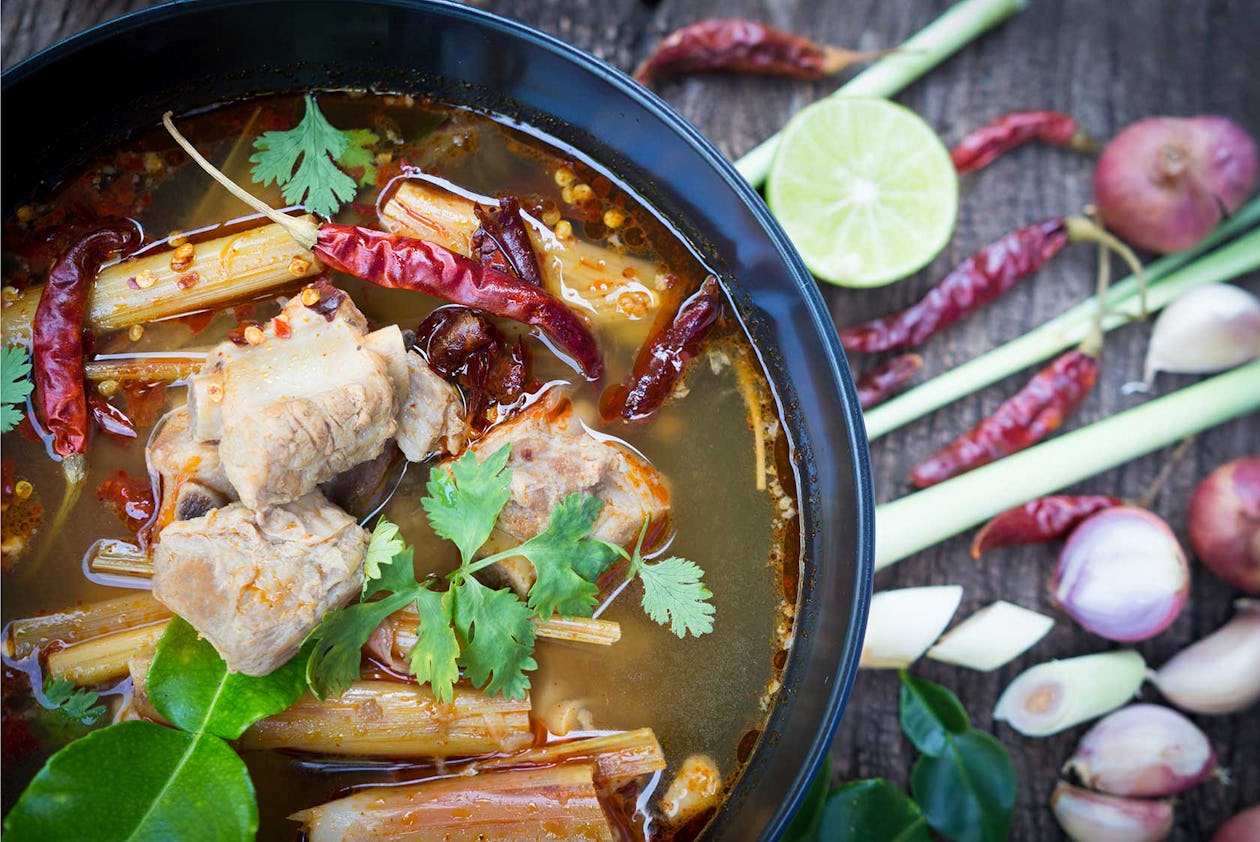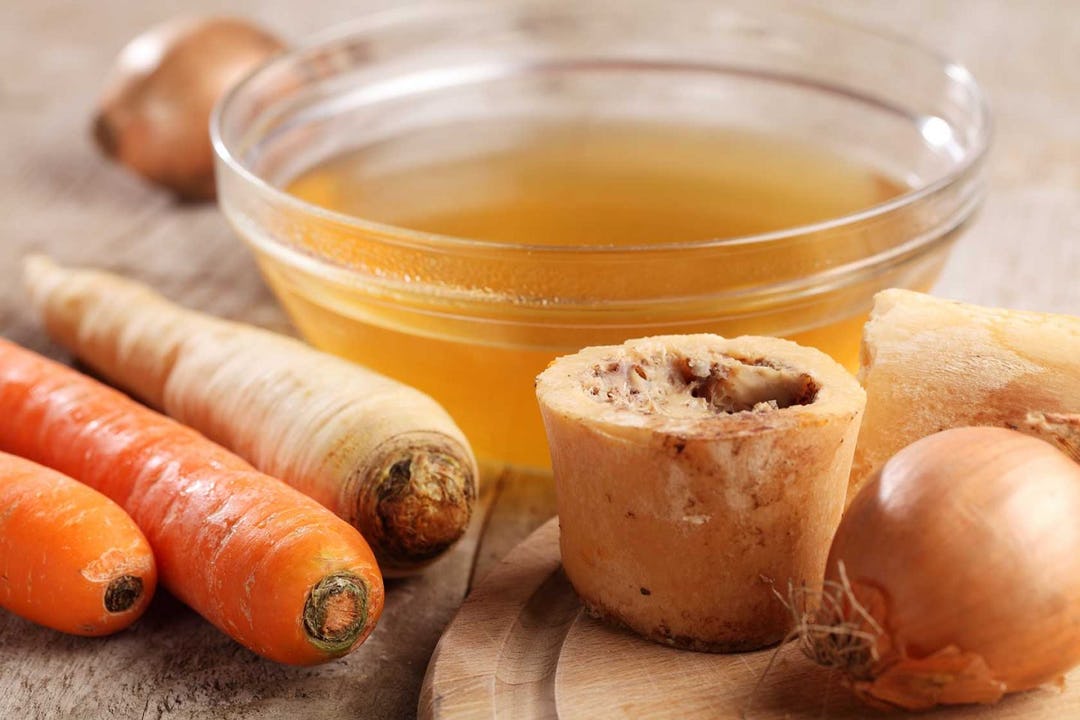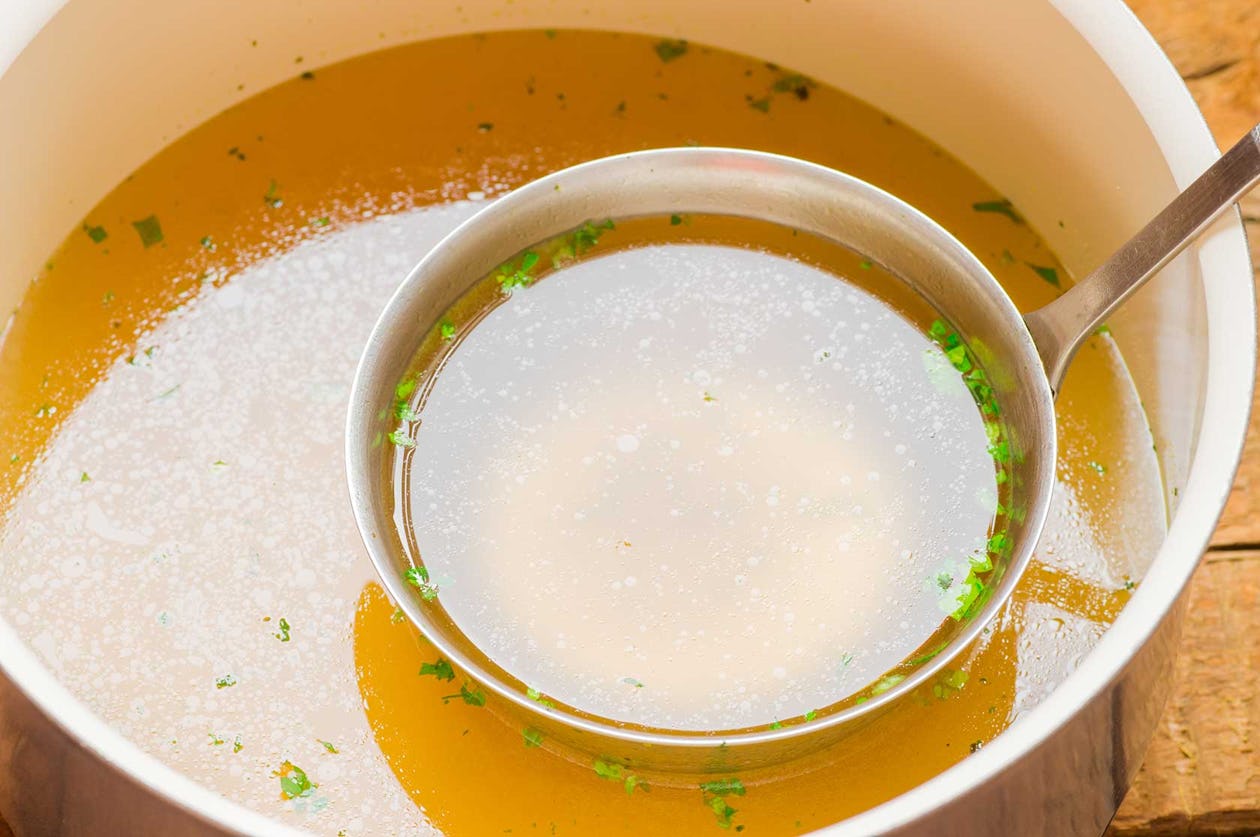Some traditions—such as human sacrifice—don’t last. Others—like drinking bone broth—do. Common in many cultures that date back thousands of years, broths made from animal bones have been used as a health tonic with benefits that range from general wellness and disease prevention to high-end athletic performance. Broth-drinking has come back into fashion in recent years (oddly, offering up virgins to sun gods hasn’t), prompting advocates to square off with critics over whether bone broth deserves its old-time reputation or is just an overhyped chicken soup.
Read our guide below, and you’ll see that bone broth is anything but bowl-shit. In fact, there’s more than enough evidence to keep the tradition alive.
What Is Bone Broth?
As with similar types of broth (see below), bone broths are the result of simmering animal parts, vegetables, and seasonings in water. Many types of animals can be used (chicken, beef, pork, and fish are the most common broths), and usually include some meat in addition to the bones for flavor. Sometimes an entire carcass is used. Mmmm, carcass.
The heat and cooking time (usually around 24 hours) draws the collagen out of the bones and connective tissues and into the water, creating a viscous and nutrient-dense liquid that can serve as the base for soups, stews, and many other meals. Bone broth is frequently consumed as a beverage as well. For the uninitiated, it tastes better than it sounds.
What’s the Difference Between Bone Broth, Stock, and Bouillon?

These terms are often used interchangeably, but, technically speaking, there are some big differences. Regular broths aren’t made with bones. They’re cooked for shorter periods of time (up to two hours) and are mainly used in soups. A standard broth typically remains liquid when chilled, while a bone broth will essentially turn to jelly due to its collagen content, as collagen becomes gelatin when heated.
A stock is made with the same animal parts as bone broth but cooked four to six hours, and it generally isn’t seasoned until later. The collagen release is great enough that, when chilled, the stock will have a gelatinous consistency as bone broth does. Or at the very least it will have a thick layer of solid on the top of the bowl. It’s often used to create a sauce or gravy as well.
Bouillon is basically dehydrated broth or stock—hence bouillon cubes or powders—and is used as a substitute. Time-saving recipes will often call for bouillon instead of broth because a cube or powder can be added to water to produce a flavorful broth quickly. However, bouillon is packed with preservatives and is very high in sodium, so nutritionists generally don’t recommend it.
What Are the Health Benefits of Bone Broth?
Here’s a quick rundown of what research has shown broths—or at least the nutrition inside of the bones and sinews used in them—can do.
Fight illness
Broths are most famous for being a home remedy for the common cold. Chicken soups are so legendary in this regard that deli-style matzo ball soup is often referred to as “Jewish penicillin.” While there’s little hard science to show that bone broths fight off colds, there is some common sense that supports it. The symptoms of colds are generally inflammatory in nature. Bone broth fuels the body with key minerals, enzymes, proteins and fats, but with minimal inflammatory distress (all meals create varying levels of inflammation). So by fueling up with minimal inflammation you are going to feel the inflammatory symptoms less.
The anti-inflammatory nature of bone broth also has just a pinch of clinical support ex-vivo as well. A study in the journal Chest exposed immune system cells to a traditional chicken soup in a Petri dish and found that some components of it had an anti-inflammatory effect that could—theoretically—reduce symptoms of illness. The authors concluded that the soup “may contain a number of substances with beneficial medicinal activity.”
Finally, as bone broths contain collagen—the protein that serves as the main component of connective tissue—they’re rich in amino acids. One of these is glycine, which has been shown to stimulate production of glutathione, a powerful antioxidant that plays a key role in preventing disease.
Promote gut health
The gut is lined with epithelial cells that are covered by a layer of mucus and a wide array of microbes. A poor diet can break down the mucus layer and allow the microbes and food you eat to permeate the intestines and enter the bloodstream, creating an inflammatory condition known as “leaky gut.” The glycine in bone broth can come to the rescue.
“It makes the cells that line the gut healthier,” says Chris Kresser, author of Unconventional Medicine and co-founder of the California Center for Functional Medicine, “so you don’t have that permeability. Gelatin absorbs water, which helps maintain the layer of mucus that keeps the gut microbes away from the intestinal barrier. Gelatin and glycine reduce inflammation in the gut.”
Speed healing
Glycosaminoglycans (GAGs) are carbohydrates that bond with proteins to make up connective tissue and the synovial fluid that lubricates the joints. During cooking, GAGs seep into broth, bringing with them the raw materials for skin, bone, tendons, and ligaments.
One type of GAG is dermatan sulfate, which, according to an article in Glycobiology, acts on cells in many different ways, including helping them regenerate and repair wounds. “Bone broth can be helpful for preventing injuries from happening in the first place,” says Kresser, “but it can also be helpful for recovery from injuries and recovery from workouts in general.” Kresser knows firsthand: “I broke a rib when I was snowboarding last year and I drank a lot of bone broth. I was able to recover more quickly than the doctors expected for someone my age.”
Additionally, a study in Current Medical Research and Opinion found that athletes who supplemented with collagen experienced less joint pain. In 2015, the Los Angeles Lakers acknowledged downing gallons of bone broth to aid recovery, with Kobe Bryant himself naming it as a factor in helping him come back from a ruptured Achilles and fractured knee. To be fair, who knows what else the Black Mamba was doing to speed recovery, but it’s a small piece of anecdotal evidence.
Bone Broth For Fitness

Apart from its potential to aid in recovery, bone broth can benefit active people and athletes in several important ways. For one thing, it’s a good source of protein, packing six to 12 grams per cup. Don’t think that makes it a suitable substitute for a protein shake—whey, Kresser says, is still superior for building muscle—but even a quick slurp counts toward your daily goal. Bone broth’s macronutrients vary a bit depending on the animal it’s sourced from, but it’s very low in carbs and fat and averages around 50 calories per cup.
The component parts of bone broth’s protein also play various roles in strength and performance. A study in Analytical Biochemistry found that glycine along with arginine boosts creatine levels in muscle cells, the energy source that powers quick-burst power exercise. Another property of glycine: increased growth hormone (hGH). A Metabolism study found that glycine supplementation induced greater hGH secretion from the pituitary gland.
Now no one’s saying that mainlining bone broth will transform you into Ivan Drago, but if bone broth’s constituents contribute to muscle and performance so directly, you can imagine how a deficiency of these nutrients in your diet could rob you of gains—or your health. According to Kresser, such a deficiency does exist, especially in people who fancy themselves “fit.”
“There are some studies in animals that have shown that a high-protein intake over a lifetime could lead to an increased risk of cancer,” says Kresser. The problem, he says, isn’t protein in general but a specific amino acid within it—methionine—which is present in high amounts in lean meats such as chicken breast and also eggs. There’s nothing wrong with methionine, per se, but high intakes of it “without sufficient amounts of supportive nutrients” could increase the risk of cancer. So if you’re a physique-conscious person who pounds protein, you could be at a higher risk.
Kresser says the solution, in general, is to eat more “nose to tail,” consuming all parts of the animal and not just the leanest cuts. (For this reason, bone broth is popular among people who follow caveman/Paleo diets.) Organ meats, for instance, contain glycine, which helps to balance out methionine levels. But who do you know who likes the taste of chicken liver?
“Organ meats are more of a stretch for some people to work into their diets, but bone broth,” says Kresser, which contains many of the same nutrients, including glycine, “is one of the most palatable ways to balance out the potential effects of excess methionine.”
Is Bone Broth Safe?
A 2013 study created a stir with findings that bone broth had high levels of lead, a metal that’s toxic to human health and especially damaging to children. But, looking deeper, the report seems unnecessarily alarmist.
First of all, after testing different types of broth (some made from bones and some not), the researchers discovered that the highest levels of lead were in a broth made from cartilage and skin—not bones. Kresser rebutted the attack at the time, arguing that the levels of lead found in bone broth were lower than what the EPA deems acceptable in tap water. He also noted that calcium interferes with lead absorption, so as long as your diet is high in calcium—and low in lead otherwise—the potential risk should be offset. The Weston A Price Foundation, a non-profit charity that disseminates information on ancestral diets, also published an article that called into question many of the study’s methods and accused it of flaws. The bottom line is that well sourced bone broth is nothing to be concerned about.
What Can I Do With Bone Broth?
Bone broth can serve as a base for soups, sauces, and stews, and can also be heated up and drunk straight (like sipping the broth out of a bowl of soup). Kresser likes to brown ground beef and then add beef broth, stewed tomatoes, sea salt and spices to flavor the meat and “raise the healing potential of it.” Note that beef bone broth is more gelatinous than chicken and most other types of bone broth. Most people also don’t find it as tasty. In this case, Kresser says you can mix it with chicken bone broth in a 50/50 combo to keep the thick consistency but enhance the flavor.
While bone broth is most commonly used as a hot liquid, it’s really much more diverse and can be an ingredient in almost any kind of food you choose to make. As it’s basically flavor-neutral without seasoning, bone broth makes an excellent carrier for other superfoods like turmeric, cayenne, ginger, and garlic, extending its taste options well beyond chicken soup while boosting its nutritional value even higher. Add oil and spices and simmer off the liquid to make a salad dressing, or let it replace butter and milk in a creamy mashed potatoes recipe. You can use bone broth as a marinade, in place of water when cooking rice or quinoa, or heat up a mug’s worth with some herbs to brew a savory tea.
We like adding emulsified MCT oil to expand the range of flavors even wider and boost levels of healthy fats.
Delicious Bone Broth Recipes
The following recipe is courtesy of Onnit Founder Aubrey Marcus’s upcoming book Own the Day, Own your Life.
Game-On Bone Broth Stew
Servings: 4
Time to prep: 20 minutes
Time to cook: 8 hours
Ingredients:
● 4 pounds buffalo or grass-fed beef bones, with the marrow, cut
●1 (750 ml) bottle organic dry red wine
●6 garlic cloves, peeled and chopped
●1 pound game meat (venison, elk, buffalo), cubed
●2 cups small purple potatoes
●2 medium carrots, peeled and chopped
●1 medium yellow onion, sliced
●1 tablespoon sea salt
●1 teaspoon black pepper
● 3 bay leaves
Directions:
1. Place the bones in 2 quarts of filtered water and bring to a boil. “Soup scum” will form at the top of the liquid—skim it off. When it’s boiling, reduce heat and simmer 3 hours.
2. Add the red wine, garlic, and meat. Simmer 3 hours.
3. Add the remaining ingredients and simmer 2 hours. Before serving, remove the bones and bay leaves.
The following two recipes are from FOND, a Texas-based bone broth kitchen.
Chilled Kale Quinoa Salad

Ingredients:
● 1 jar FOND Trolley Dodger bone broth (or other bone broth infused with garlic, radishes, onion, and lemon)
● 1 cup quinoa
● 2 tbsp avocado oil
● 1 bunch kale, roughly chopped
● ¼ cup red pepper, chopped
● 1 tbsp MCT oil
● Salt to taste (preferably Himalayan pink salt)
Directions:
1. Add the bone broth to a deep saucepan, and then add the quinoa and avocado oil. Bring to a boil and then reduce heat and simmer 25 minutes.
2. Add the kale and red pepper and simmer for another 5 minutes or until the pepper is tender. Salt to taste and stir in the MCT oil. Let chill for 2 hours.
The liquid in the broth will evaporate, leaving you with a rich, fully dressed salad.
Dairy-Free Mashed Potatoes

Ingredients:
● 3 lbs organic potatoes (any kind is OK), cut into cubes
● 4–8 oz bone broth (FOND’s Trolley Dodger is perfect)
● 1 tbsp MCT oil
● Salt and pepper (optional)
Directions:
1. Place cubed potatoes in a deep saucepan. Cover with cold water and bring to a boil. Reduce heat and simmer 20 minutes or until the potatoes are soft when pierced with a fork.
2. Strain water and pour bone broth into the pan. If you want to puree the potatoes, use 8 ounces of the broth. If you like your mashed potatoes thicker, you will only need closer to 4.
3. Add the MCT oil and use an immersion blender to mash the potatoes to your desired thickness.
If conventional mashed potatoes weigh you down, you’ll find this version much lighter, but no less creamy or flavorful.
What’s The Best Bone Broth to Buy?
When shopping for a pre-made bone broth, it’s important to find an authentic one—not just another chicken soup. “If you put a chicken in hot water and boiled it for 30 minutes,” says Kresser, “you’d get a broth that tastes like chicken but it’s not bone broth. It hasn’t been simmered long enough for any of the nutrients from the bones or cartilage to get into the broth. A lot of commercial broths you buy don’t have those nutrients.”
To ensure that you get one that does, look specifically for “bone broth” on the label. In addition to FOND, Kresser recommends the brands Kettle & Fire (our chief optimizer Aubrey Marcus admits to being addicted to the chicken and mushroom flavor) and Pacific Foods. One way to tell if your broth is legit is to chill it. “We like to have our customers perform a quick gelatin test,” says Alysa Seeland, co-founder of FOND. “You put a cup of bone broth in the freezer for 20–30 minutes. If it starts to gel then you know it’s good.” If it doesn’t, your broth wasn’t made with bones or wasn’t cooked long enough to draw the collagen out of them—so it’s just plain soup.
As with most of the animal products you consume, you should make an effort to buy bone broth made from animals that were pasture-raised and are certified organic. The extra money is worth it. “Toxins are typically stored in fat and in the bones,” says Kresser, “so using animals that have a lower toxic load is beneficial.” An article in the journal Meat Science agrees, concluding that the “organic production system seems to be a good alternative method, due to better welfare conditions and good quality of the carcass and meat.”
How Do I Make Bone Broth?
The only way to ensure that your bone broth is the best possible quality is to make it yourself. Seeland offers the following recipe to broth-brewing newbies.
Fool-Proof Chicken Bone Broth
Ingredients:
● 2 tbsp organic apple cider vinegar
● 1 bay leaf
● 3 stalks of organic celery, chopped
● 3 organic carrots, chopped
● 1 small organic onion, diced (omit if you have an inflammatory issue made worse by sulfur)
● 2 lbs pasture-raised chicken carcass (can be raw or cooked,
fresh or frozen, and can include organ meats like liver)
● 1 lb pasture-raised chicken feet
● 1 tbsp Himalayan salt
● Fresh herbs (whatever flavors you like)
● 1 lemon wedge, juiced
Directions:
1. Add all of the ingredients excluding the salt, herbs, and lemon juice to a stainless steel stockpot. Add water until it just covers the vegetables and bones. Bring to a boil.
2. Skim off the “soup scum” that rises to the top. Boil for 10 minutes, continuing to skim off the scum as it forms. Reduce heat and simmer for 20–24 hours.
3. Strain the bone broth and add the salt, fresh herbs, and lemon juice. This bone broth will keep for 7 days in the refrigerator.
Other brothing tips: don’t exclude the feet because they’re “gross.” Kresser says that the bones and sinews in the feet—and even the head—of the animal make a huge difference and lead to a more gelatinous broth (a good thing). “If you’re buying chicken for broth, ask the butcher to include the head and the feet,” says Kresser. “They’ll be happy to do it, because they’re just going to throw them out anyway.” Apple cider vinegar is another key ingredient, as it helps break down the bones, releasing more nutrients into the broth. You can experiment with cooking times, but be patient. Generally, the longer you cook it, the more flavorful and nutritious your broth will be, up to 24 hours.


)






